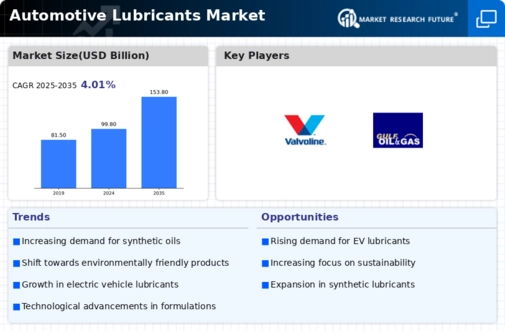Market Share
Automotive Lubricants Market Share Analysis
In the highly competitive Automotive Lubricants Market, companies employ various strategies to position themselves effectively and capture market share. One common approach is differentiation, where companies strive to distinguish their products from competitors through unique features or benefits. For instance, some companies may focus on developing lubricants specifically tailored to certain vehicle types or engine technologies, such as high-performance sports cars or electric vehicles. By catering to niche segments with specialized products, companies can carve out a loyal customer base and command premium pricing, thereby enhancing their market share.
Various factors drive the demand for automotive lubricants market all across the globe. Lubricants used in industrial operations help the company in saving cost as the lubricated machines produce less friction and hence require less fuel, and emit carbon dioxide in less amount.
Another key strategy is cost leadership, wherein companies aim to become the lowest-cost producer in the market. This often involves streamlining manufacturing processes, optimizing supply chain efficiencies, and negotiating favorable deals with suppliers. By offering competitively priced lubricants without compromising on quality, companies can attract price-sensitive customers and gain market share, especially in price-sensitive segments or regions where affordability is a significant factor influencing purchasing decisions.
Furthermore, innovation plays a crucial role in market share positioning within the Automotive Lubricants Market. Companies invest heavily in research and development to create cutting-edge formulations that deliver superior performance, durability, and environmental sustainability. By introducing innovative products that outperform conventional lubricants, companies can capture the attention of discerning customers and gain a competitive edge in the market. Additionally, innovation allows companies to stay ahead of regulatory requirements and address evolving consumer preferences, further solidifying their market share.
Moreover, effective branding and marketing strategies are essential for companies vying for market share in the Automotive Lubricants Market. Building a strong brand image and establishing brand equity can significantly influence consumers' purchasing decisions, especially in a market where trust and reliability are paramount. Companies invest in marketing campaigns that highlight the unique value propositions of their products, such as superior engine protection, fuel efficiency, or extended maintenance intervals. By effectively communicating these benefits to consumers through various channels, including digital media, advertising, and sponsorships, companies can enhance brand visibility and preference, ultimately leading to increased market share.
Furthermore, strategic partnerships and alliances can be instrumental in expanding market share within the Automotive Lubricants Market. Collaborating with automotive manufacturers, dealerships, and aftermarket service providers allows companies to gain access to a broader customer base and distribution network. By aligning with trusted industry players and leveraging their existing relationships, companies can accelerate market penetration and strengthen their competitive position. Strategic partnerships also provide opportunities for co-branding initiatives, joint product development, and cross-promotional activities, which can further enhance brand recognition and customer loyalty.
Lastly, geographical expansion and market diversification are vital components of market share positioning strategies in the Automotive Lubricants Market. Companies seek to capitalize on growth opportunities in emerging markets by expanding their presence and distribution channels. Additionally, diversifying product offerings to cater to different vehicle segments, applications, and industries reduces dependency on specific market segments and enhances resilience against market fluctuations. By adopting a balanced approach to geographical expansion and product diversification, companies can mitigate risks and optimize their market share across various regions and market segments, ensuring long-term sustainability and competitiveness in the Automotive Lubricants Market.

















Leave a Comment